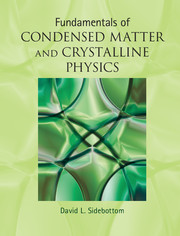 Fundamentals of Condensed Matter and Crystalline Physics
Fundamentals of Condensed Matter and Crystalline Physics Book contents
7 - Scattering by amorphous matter
from Part II - Scattering
Published online by Cambridge University Press: 05 August 2012
Summary
Introduction
In contrast to the sharp, discrete scattering that occurs in crystals as a result of their perfect periodicity, amorphous materials possess a distribution of particle spacings and display scattering that is far more continuous as a function of the scattering wave vector. In this chapter, we explore in detail the relationship between the structure factor of a liquid or glass and the corresponding short-range order described by the pair distribution function introduced in Chapter 2. We demonstrate that S(q) is (mostly) a Fourier transform of the pair distribution function. Thus again, prominent features of the static structure factor point to recurrent particle spacings present in the material, and provide vital experimental clues to the short-range order.
In this chapter, we also look at how visible light is scattered by liquids and glasses. Unlike X-rays that probe mainly the short-range order resident over just a few coordination layers, the larger wavelength of visible light makes it sensitive to larger-scaled density variations caused by thermal fluctuations. In this alternative scattering regime, the pattern of density fluctuations is described by the van Hove correlation function which, again, is related to S(q) by a Fourier transform.
- Type
- Chapter
- Information
- Fundamentals of Condensed Matter and Crystalline PhysicsAn Introduction for Students of Physics and Materials Science, pp. 95 - 108Publisher: Cambridge University PressPrint publication year: 2012


